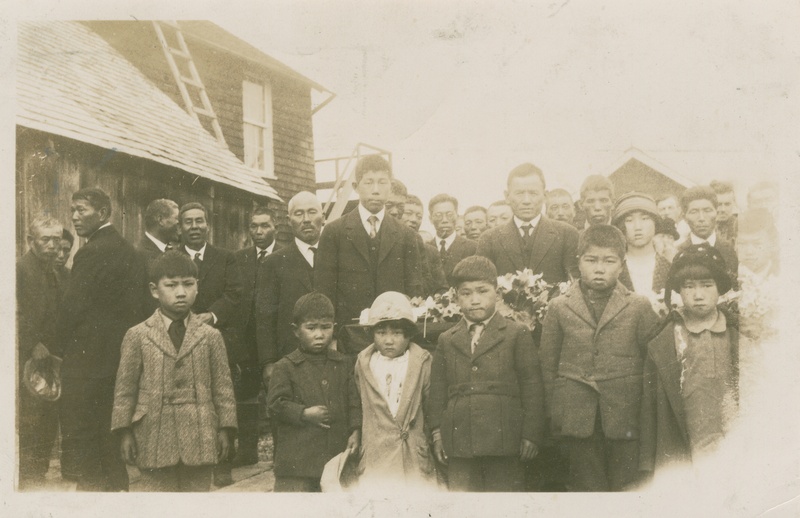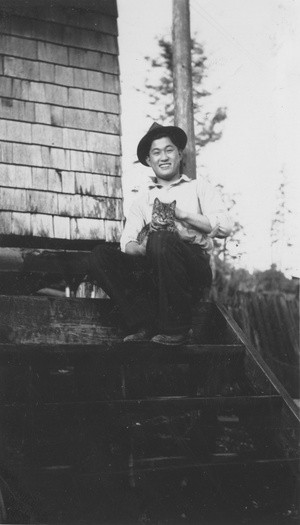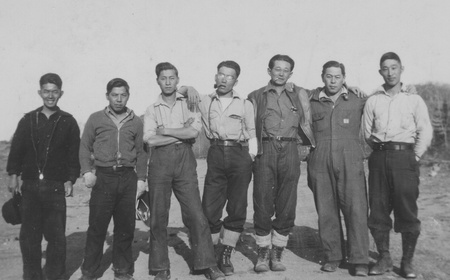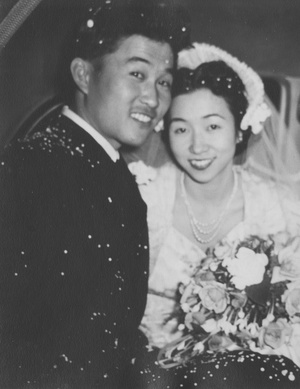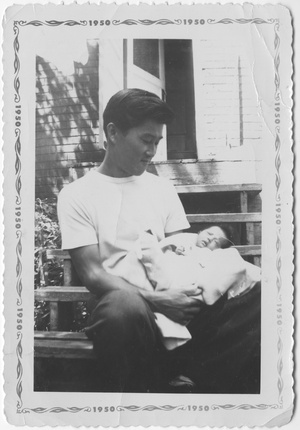Early life
Thomas Hiroshi Madokoro was born in Steveston on June 7, 1920 to Tamezo and Hine (Ezaki) Madokoro. Tamezo had come to Canada around 1880 with his brother Rinshiro from Shimasato Wakayama ken. Both were fishermen. About two years later, the family moved to Tofino. They lived in Storm Bay with seven other families: the Mori, Morishita, M. Nakagawa and S. Nakagawa, Nakatsu, Yamada, Izumi, and Kondo families.
Tamezo and Hine had five children: Yoshio (John), Yaeko (Mary), Michi (Andrew), Kuni (Frances), Nakagawa, and Hiroshi (Thomas).
In the house in Storm Bay, the boys slept upstairs on futons. Thomas remembers walking a mile to a one-room school in Tofino that included grades one to eight. He was a mischievous child and remembers getting the strap all the time from an English teacher who was strict. Thomas and his siblings were baptized in the Anglican Church in Tofino, which was how all the children got English names.
Tamezo died in Storm Bay in 1929, so John, the eldest son, had to quit school. He took over his father's boat, Gloom, and was mentored by his uncle Rinshiro to fish and support the family. The family took his father’s body to Vancouver to be cremated.
In 1930, when Thomas was about 11, Hine took him to join Yaeko and Michi, who were schoolchildren in Vancouver, working in domestic service. Yaeko and Michi were living with white families, attending school during the day and housekeeping after school. Hine got a job peeling shrimp to support them. They lived in the Fairview district in a rented home at 4th Avenue and Alberta Street. Thomas attended the Fairview Japanese Language School, whose principal was Mr. Miyashida. Thomas again was caught daydreaming or singing his own tunes and was hit on the head by the teacher.
Working life
When Thomas was 16, his brother John got him a job at the Tofino Co-op. The whole family moved back to Tofino and rented a house there. Thomas’s first job was to ice fish in the Co-op. At age 18 he worked as a cook on the Western Chief, the big packer owned by the Tofino Co-op. The first boat he owned was a dugout canoe, which he bought from a First Nations owner for $10. He caught coho in it with a line and spooner, and often took his nephew and niece, Richard and May Seko, out in it for fun.
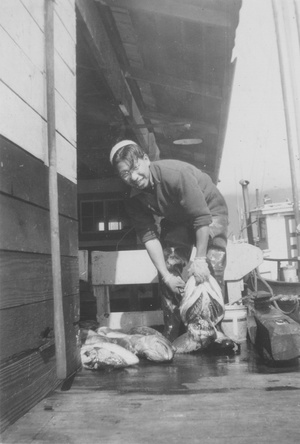
Thomas bought his uncle’s boat when he retired and returned to Japan in 1939. The HM, a trawler, was Japanese-built, although it is not known by whom. Then he took over his brother’s boat when John bought a new one in about 1941.
Boat confiscated
In 1942, following the Japanese attack on Pearl Harbor, the Canadian government seized the property of Japanese Canadians and moved them away from the west coast. Thomas recalled: “The Mounties came by plane to Tofino. They told us not to move the boats, don’t use them anymore. There were about 30 boats. We had to take them to Annieville. There was a navy guy on my boat with a gun. But most of the time he didn't do anything, just lay down in the cabin. First we picked up the Ucluelet boats, then the Bamfield boats, the Pachina boats, and the Carmannah boats. It was a long day. It got dark and hard to see, and some boats got lost. Some ended up in the USA, and they got shot at. Luckily no one got hurt. Some drifted for a while but finally made it. We were hungry, hadn’t had food for three days. When we got to Annieville, the Navy took over the boats. Some got sunk because they didn’'t know what they were doing. Some of the shallow boats got full and tipped over. Scavengers on the beaches were taking what washed up and sold it off. After the boats were delivered, all the men came back to Tofino, but a week later, we were told that we had to go to a road camp and had 24 hours to pack up.”
Thomas agreed to cooperate as he did not wish to go to an internment camp. Twenty-two men from Tofino decided to go in March 1942, one of the first groups to go to the Schreiber-Jackfish Road camp in Ontario. Shortly after that, Thomas went to Black Camp (which was full of blackflies), then to a sugar beet farm at Glencoe, then to Toronto.
Thomas met his wife, Sachi Tsumura, who was the sister of his friend, John Tsumura. Before the war, the Tsumura family had built yachts in Prince Rupert. When the internment began, the Tsumura family was sent to Hastings Park, then to a camp Popoff. In 1946, they moved to Meaford, Ontario. While in Popoff, Sachi worked in the welfare office.
Thomas and Sachi were married in 1949 in Toronto and went to Niagara Falls on their honeymoon. Their daughter, Wanda, was born in Toronto one year later.
After the war, B.C. Packers offered the fishermen a loan to help them get set up again. Thomas took them up on their offer and borrowed $35,000 for one of 12 boats on offer, the Hyson, which was built in 1950 by Osborne Shipyards in Port Alberni. He paid it off in just a few years. He bought a home next door to the Tsumura boat works on River Road in Sunbury, the Deltaga Boatworks. He then moved to north Delta and lived there for 58 years. He sold the Hyson to Ericson and in 1960 he bought a Tsumura boat, the Hyson II. This was a state-of-the-art boat, one of 50 or 60 they had built. It was smooth-riding, had a depth sounder and radar, and was faster and roomier than Thomas’s previous boats. This was a high boat for bigger catches, and Thomas was the first Japanese Canadian to buy such a sleek new boat which could now fish in the fog. He was one of the best fishermen for B.C. Packers.
Later, when herring roe became popular in Japan, buyers offered cash when the fishers brought the boats in, right at the wharves, and Thomas made a fortune.
Thomas fished until he was 80, somewhere around 2000.
*This article was originally published in Nikkei Images, Volume 22, No. 3.
© 2017 Thomas Hiroshi Madokoro


